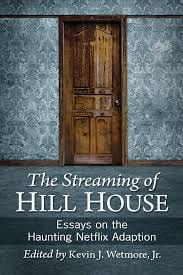I have a chapter on Mike Flanagan’s Netflix series, The Haunting of Hill House, in Kevin Wetmore’s edited collection on the series, The Streaming of Hill House: Essays on the Haunting Netflix Adaptation (McFarland, 2020).
I’m including my introduction below, so you can see where I go with the essay . . . One of the big–and very pleasant–surprises for me was ending up at H. P. Lovecraft’s “The Shunned House.” I discovered the connection as I was writing and it’s one of those things I plan to pursue more elsewhere, as I only scratch the surface here . . . .
“One of the most striking differences of Mike Flanagan’s serial adaptation of The Haunting of Hill House (2018) is the ubiquitous presence of black mold. Mold is only mentioned in Shirley Jackson’s novel (1959) when the group first ventures into the library and Eleanor stops at the door, “overwhelmed with the cold air of mold and earth which rushed at her.”[i] Mold makes no appearance at all in Robert Wise’s 1963 film adaptation, The Haunting. In the Netflix series, by contrast, Hugh Crain discovers “veins of mold” spreading over the basement walls in episode seven, and from then on mold is central to the story. The origin of the black mold is the infamous red room, which appears to have been locked through most of the series but which has in fact been inhabited by all the characters (except Hugh), who each experience it as a different room. The final episode of the series takes place almost entirely in the red room, and, as it extends from the walls to the characters, the black mold is integral to the conclusion of the series.
The mold of Hill House is an earthly spreading of organic matter, and the materialism that creeps in with the mold is evidenced in one possible reading of Flanagan’s Haunting: what happens in Hill House is due to the toxic effects of black mold. This chapter takes up this reading but then argues that what haunts the characters is mute matter more broadly—that which they see and think they understand, that which they see and don’t understand, and that which some of them don’t even see. In centering the mold, I offer a “weird reading,”[ii] one that runs against the grain of the primarily psychological interpretations of Haunting (in all its iterations). As Mark Fisher aptly defines it, the weird is “that which does not belong.” The weird “brings to the familiar something which ordinarily lies beyond it, and which cannot be reconciled with the ‘homely.’”[iii] The mold “does not belong” in Hill House: not least, it is one of the principal ways in which Flanagan’s version diverges from the novel. More profoundly, though, the mold signals the nonhuman life that does not belong in what Eileen Joy calls the “psychic-cultural-historical order” that literary and film criticism is typically dedicated to exploring.[iv] The mold, especially as it overruns everything, including the characters, does not belong in an anthropocentric world; it dislodges the human, showing how vulnerable we are to the spread of matter, to being consumed by matter, to becoming matter. Foregrounding the mold, this reading “ungrounds” Haunting from its “conventional, human-centered contexts.”[v] It is attuned to other-than human agencies. The mold ushers in the weird, orienting us to the power of the nonhuman, suggesting that “ghosts” are not emanations from either the psyche (as Steven insists) or from the spirit world; they are manifestations of a material world vaster and more inscrutable than we know.”
[i] Jackson, Haunting, 75; further references to this novel will be inserted parenthetically in the text.
[ii] This is the title of Eileen A. Joy’s essay.
[iii] Fisher, Weird, 10-11.
[iv] Joy, “Weird,” 29.
[v] Ibid., 29.

Leave a Reply